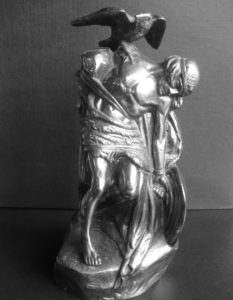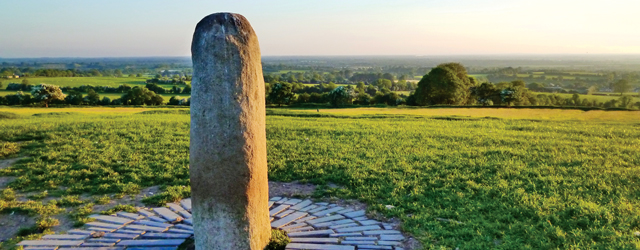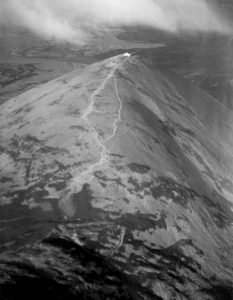Above: Hill of Tara
By Carmel McCaffrey
Although Christianity arrived in Ireland in the fifth century AD it did not come to a society unfamiliar with religious rituals or bereft of any deity. On the contrary, the new arrival came to an Irish world that had vibrant religious practices with sacred ritual sites that dotted the entire countryside.
What we nowadays refer to as the ‘Celtic’ culture was a central part of Irish life. This included laws, language and religion. The ancient Irish texts written in early Christian times describe the customs and way of life in Ireland prior to the arrival of Christianity.
There was the old law system known as Brehon law, which remained customary in Ireland until the early 1600s. The vernacular language, the Irish language, is still spoken in parts of Ireland today and is an important part of the Irish school curriculum. A fascinating feature of this world was the religion that dominated everyday life with ritualistic worshipping of various gods and goddesses.

Emain Macha or Navan Fort— now in modern day County Armagh. This mound was an important religious ritual site in pre-Christian Ireland.
The pantheon of Irish gods and goddesses is called the Tuatha Dé Danann. The festivals of these deities were the principal days of worship. It was a pastoral religion primarily associated with nature, fertility and, in practical terms, the very survival of the tribe in times of bad harvests or disease.
The feast days and rituals in the Celtic religion were centered round the calendar year and the changing seasons. They were celebrated on what are known as the cross-quarter days of the yearly cycle of the sun. The mid-winter solstice falls in December and the mid-summer solstice falls in June so the feasts of the cross-quarter year are February 1st, May 1st, August 1st and November 1st. These were the most important religious dates in the year when the Druids would preside over events aimed at pleasing the gods and goddesses and ensuring that the tribe would have good fortune shine on them. Enormous fires were lit at these celebrations.
These were also times of peace and goodwill and essentially, what we might recognize as party time. The Hill of Tara in present day County Meath was the principal place of worship but there were other sites throughout the country including Rath Croghan in the west and Emain Macha in the north where great crowds would gather on the feast days.
One of the purposes of these religious gatherings was to have a celebration with your family and neighbors and enjoy yourself. We get an idea of how congenial and important these festivals were from an edict which states that a punishment for breaking the law could be exclusion from one of these religious celebrations. Banishment from a religious gathering was ostracism for the wrongdoer. To have missed participation might also have been a foreboding omen of bad luck for the coming year. As Christianity spread throughout Ireland many of these pagan feasts were skillfully incorporated into the Christian calendar.
SAMAIN
The most significant time of the year was the ending of the old year and the start of the new one on November 1st. This feast was known as Samain. This was the central feast day in the Irish calendar. It was the feast of the principle god, the tribal god, the Dagda, sometimes referred to as Ollathair, the great father of all the tribe. He is usually depicted carrying a large club, to bash the enemies of his people, and a giant cauldron full of food to feed everyone.
The goddess of the feast was the Morrigan, a prophetess and goddess of battle and death, who sometimes takes the shape of a raven to guide the dying to the Otherworld. Because the feast is associated with the death of the old year and the birth of the new it was believed that the spirits of the dead arose and momentarily walked the earth.
The celebrations began on the evening before Samain on what was called Oice Samain or the Eve of Samain, Oct 31st. This night stood on the boundary between the old year and the new year and it was believed that the barriers between the living world and the Otherworld temporarily disappeared. The two worlds of the living and the dead became visible to each other.
We know from the old Irish texts that on this evening the tombs in the ancient burial mounds would be opened to allow the spirits of the dead to emerge and mingle with the living. The gods and goddesses also moved freely about amongst the living during this night. Now this might be a good or bad thing depending on whether a living person had done something to distress the dead or the gods. If this was the case then the dead could return to avenge the wrong and the living would dress up in disguise to put them off the trail or hide from them. In Christian times this evening became All Hollows’ Eve or Hallowe’en.
IMBOLG
The arrival of spring was marked by a festival known as Imbolg which was held on February 1st. This date celebrated the new season of growth and the awaking of the earth after the winter. The goddess Brigid is the chief deity associated with this time. She was the patron of poetry, crafts and healing. She also had a particularly feminine dimension in that she was invoked by women in childbirth for protection and safe delivery of the child. In later Christian times the date of Imbolg was proclaimed as the feast of Saint Brigid.

The Morrigan goddess in Irish art— Oliver Sheppards’ statue of Cuchulain with the goddess Morrigan taking the shape of a raven and sitting on the shoulder of Cuchulain as he dies. The original statue is in the GPO Dublin and commemorates the 1916 Rising.
BELTINE
On May 1st, the festival that was celebrated was called Beltine. As with the other religious feasts this one is linked with the season and with nature. Beltine celebrated the beginning of open pasturing. A ceremonial bonfire was lit to please the sun and ask it to shine on the crops and the pasture. The word ‘Bel’ comes from an old Celtic word for bright light meaning, probably, the sun’s light. The Celtic god Belenus is associated with the sun. The ‘tine’ means a fire so it was the time of Bel’s fire or the fire of the Sun God. Some sources tell of large fires being built in long lines parallel to each other. When the fires were blazing high, cattle would be driven down the burning avenue between the flames in the belief that they would be purified and freed from any disease. Whether any of the animals ended up being scorched we do not know!
LUGNASA
The feast of Lugnasa signaled the start of autumn. The chief day was on August 1st and honored the Celtic god Lugh. This was the second most important festival after Samain. It was also one of the longest in duration as it traditionally began in mid July and lasted until mid August. Lugh is one of the most interesting and gifted of the gods of Ireland.
He is described as beautiful in appearance and seems to have been a much loved deity. Lugh was youthful, athletic and handsome. He is the most versatile of the gods being also a harpist, a sorcerer, a sports champion and a craftsman. Some stories tell of Lugh dying and then resurrecting himself and saving the earth from insects that might eat or harm the harvest. He is both the protector of the harvest and the provider of a good time.
We know that much of this older religion impacted on Christianity when it arrived in Ireland in the fifth century and that even today pagan practices are still to be found mingled with Christian ritual. With such obvious persistence, we can speculate with confidence that it must have been a fundamental and powerful presence in the lives of Irish people at the time.
Carmel McCaffrey was the chief historical consultant for the PBS/RTÉ three-part television series “In Search of Ancient Ireland “and is the co-author of the accompanying book of the same title.


